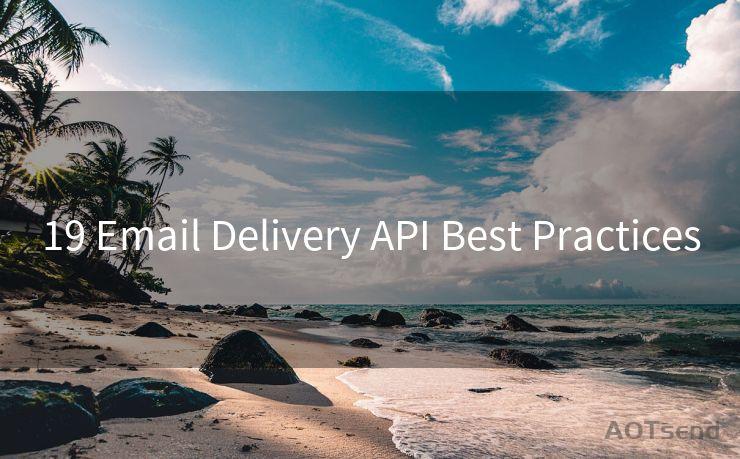19 Email Delivery API Best Practices




When it comes to email delivery, using an API (Application Programming Interface) effectively can make or break your communication strategy. To ensure your emails reach their intended recipients promptly and securely, it's crucial to follow best practices. Here are 19 email delivery API best practices that will help you achieve optimal performance.
1. Choose a Reliable Email Delivery Service
Selecting a trusted email delivery service with a robust API is the first step. Look for providers with a proven track record in deliverability, scalability, and security.
2. Understand the API Documentation
Before integrating the API, thoroughly read and understand the provider's documentation. This will help you avoid common pitfalls and make the most of the API's features.
3. Authenticate Your Emails
Implementing authentication protocols like SPF (Sender Policy Framework), DKIM (DomainKeys Identified Mail), and DMARC (Domain-based Message Authentication, Reporting, and Conformance) is essential. These protocols verify the sender's identity and enhance email deliverability.
4. Maintain a Clean Sender Reputation
Monitor your sender reputation regularly. Avoid sending spam or unsolicited emails, as they can harm your reputation and affect deliverability.
5. Optimize Your Email Content
Craft emails with relevant and engaging content. Avoid using spammy words or phrases that might trigger spam filters.
6. Segment Your Audience
Targeting specific audience segments with relevant content improves engagement and reduces the chances of being marked as spam.
7. Test Email Deliverability
Regularly test your emails for deliverability using tools like Mail-Tester or GlockApps. This helps identify and fix potential issues before they affect your campaigns.
8. Handle Bounces and Complaints
Implement a system to track and manage bounces and complaints. Remove hard bounces and address soft bounces promptly.
9. Follow CAN-SPAM Act Guidelines
Ensure your emails comply with the CAN-SPAM Act, which requires accurate header information, a clear opt-out mechanism, and relevant content.
10. Monitor Blacklists
Check if your sending IP or domain is blacklisted. Use tools like MX Toolbox or MultiRBL to stay informed.
11. Throttle Your Email Sending Rate
Avoid sending too many emails too quickly, as this can trigger spam filters. Gradually increase your sending rate over time.
12. Utilize Feedback Loops
Participate in feedback loops offered by ISPs (Internet Service Providers). This helps you identify and address complaints promptly.
13. Optimize Your Email Infrastructure
Ensure your email infrastructure is scalable and reliable. Consider using a dedicated IP address and a reputable hosting provider.
14. Implement Retry Logic
Incorporate retry logic into your email delivery system. This allows for reattempts in case of temporary failures.
15. Monitor Email Metrics
Track key metrics like open rates, click-through rates, and unsubscribe rates. Use these insights to improve your email strategy.
16. Stay Updated on Industry Trends
Keep abreast of the latest email marketing and deliverability trends. This helps you stay ahead of the curve and adapt to changing landscapes.

17. Handle Unsubscribes Gracefully
Respect user preferences and remove unsubscribed users from your mailing lists promptly.
🔔🔔🔔
【AOTsend Email API】:AOTsend is a Managed Email Service for sending transactional emails. Support Email Types: reminders, authentication, confirmations, notifications, verification codes, invoices, password resets, account activations, billing statements, two-factor authentication (2FA), and one-time passwords (OTP) emails, etc. $0.28 per 1000 Emails. 99% Delivery, 98% Inbox Rate.
You might be interested in:
Why did we start the AOTsend project, Brand Story?
What is a Managed Email API, How it Works?
Best 25+ Email Marketing Platforms (Authority,Keywords&Traffic Comparison)
Best 24+ Email Marketing Service (Price, Pros&Cons Comparison)
Email APIs vs SMTP: How they Works, Any Difference?
18. Use Double Opt-In for Subscriptions
Implement a double opt-in process for new subscriptions. This ensures that only engaged and interested users receive your emails.
19. Continuously Monitor and Improve
Regularly review your email delivery performance and make adjustments based on data and feedback.
By following these 19 email delivery API best practices, you can significantly improve your email deliverability, engagement, and overall marketing effectiveness. Remember, email marketing is an ongoing process that requires continuous monitoring and optimization to achieve the best results.




Scan the QR code to access on your mobile device.
Copyright notice: This article is published by AotSend. Reproduction requires attribution.
Article Link:https://www.mailwot.com/p5706.html



